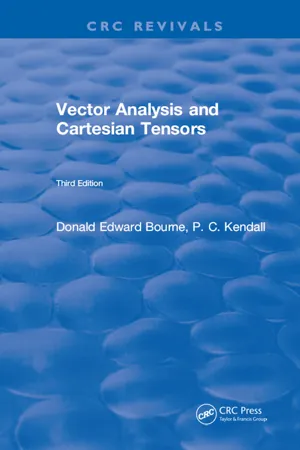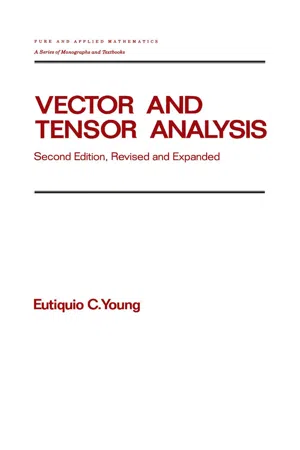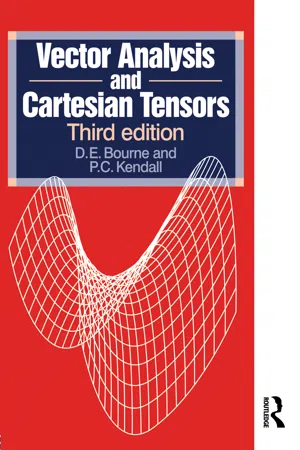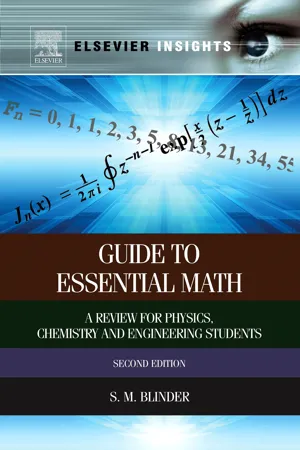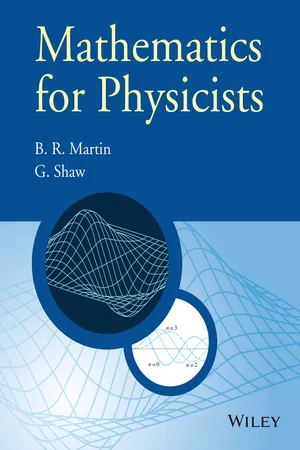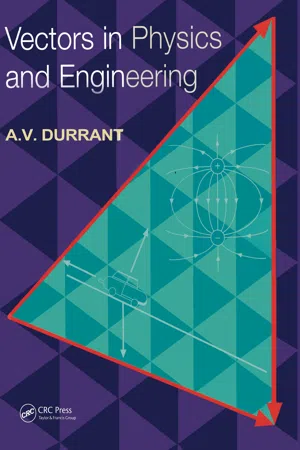Physics
Scalar
In physics, a scalar is a physical quantity that is fully described by its magnitude or size, without any direction. Scalars are characterized by their magnitude alone and do not have a specific direction associated with them. Examples of scalars include temperature, mass, and speed.
Written by Perlego with AI-assistance
Related key terms
Related key terms
1 of 4
Related key terms
1 of 3
8 Key excerpts on "Scalar"
- eBook - ePub
Vector Analysis and Cartesian Tensors
Third Edition
- Donald Edward Bourne(Author)
- 2018(Publication Date)
- Chapman and Hall/CRC(Publisher)
Scalar and vector algebra 2 2.1 ScalarSAny mathematical entity or any property of a physical system which can be represented by a single real number is called a Scalar. In the case of a physical property, the single real number will be a measure of the property in some chosen units (e.g. kilogrammes, metres, seconds).Particular examples of Scalars are: (i) the modulus of a complex number; (ii) mass; (iii) volume; (iv) temperature. Note that real numbers are themselves Scalars.Single letters printed in italics (such as a, b, c, etc.) will be used to denote real numbers representing Scalars. For convenience statements like ‘let a be a real number representing a Scalar’ will be abbreviated to ‘let a be a Scalar’.Equality of Scalars Two Scalars (measured in the same units if they are physical properties) are said to be equal if the real numbers representing them are equal.It will be assumed throughout this book that in the case of physical entities the same units are used on both sides of any equality sign.Scalar addition, subtraction, multiplication and divisionThe sum of two Scalars is defined as the sum of the real numbers representing them. Similarly, Scalar subtraction, multiplication and division are defined by the corresponding operations on the representative numbers. In the case of physical Scalars, the operations of addition and subtraction are physically meaningful only for similar Scalars such as two lengths or two masses.Some care is necessary in the matter of units. For example, if a, b are two physical Scalars it is meaningful to say their sum is a + b only if the units of measurement are the same.Again, consider the equationT =giving the kinetic energy T of a particle of mass m travelling with speed v. If T has the value 30 kg m2 s−2 and v has the value 0.1 km s−1 , then to calculate m = 2T/v2 consistent units for length and time must first be introduced. Thus, converting the given speed to m s−1 we find v has the value 100 m s−1 . Hence the value of m1 2mv 2 - eBook - ePub
- Eutiquio C. Young(Author)
- 2017(Publication Date)
- CRC Press(Publisher)
1VECTOR ALGEBRA1.1 Introduction
In the study of physics and engineering, we encounter many important quantities which can be described by the specification of their magnitude alone in terms of some appropriate units. For example, the volume of a cube can be described by the number of cubic inches or cubic centimeters, and the temperature at a particular time of a day can be described by giving the number of degrees on a Fahrenheit scale or a Centigrade scale. Such quantities characterized by the fact that they have magnitude only are called Scalar quantities. Scalar quantities are represented by real numbers, and they are also called Scalars. On the other hand, there are many other physical quantities such as displacement, force, velocity, and acceleration which cannot be described by the specification of their magnitude alone. These quantities possess not only magnitude but also direction so that a complete description of any such quantity must specify these two pieces of information. Thus when a weatherman reports the wind velocity on a particular day, he specifies not only the speed of the wind (magnitude of the wind velocity), but also the direction from which the wind is blowing. Such quantities characterized by having magnitude and direction are called vector quantities.Just as we use real numbers or Scalars to represent and manipulate Scalar quantities, so we use the mathematical entities called vectors to represent and manipulate vector quantities. Thus, in a sense, vectors can be thought of as generalized numbers. The study of the representation of vectors, the algebra and calculus of vectors, together with some of their various applications constitute the subject matter of vector analysis.Scalars and vectors are hardly sufficient to treat the class of quantities that are of interest in physics, engineering, and applied mathematics. In fact, there are quantities of a more complicated structure whose description requires more than knowledge of a magnitude and a direction. For example, to describe a quantity such as stress, we need to give a force (described by a vector) and a surface on which the force acts. Such a quantity can be described and represented only by the more sophisticated mathematical entity called tensor. As we shall see later, Scalars and vectors are actually special cases of tensors. This is in accord with an important characteristic of mathematics in which concepts of more general nature do incorporate as particular cases those from which the concepts originated in the first place. - P C Kendall(Author)
- 2017(Publication Date)
- Routledge(Publisher)
2 Scalar and vector algebra2.1 Scalars
Any mathematical entity or any property of a physical system which can be represented by a single real number is called a Scalar . In the case of a physical property, the single real number will be a measure of the property in some chosen units (e.g. kilogrammes, metres, seconds).Particular examples of Scalars are: (i) the modulus of a complex number; (ii) mass; (iii) volume; (iv) temperature. Note that real numbers are themselves Scalars.Single letters printed in italics (such as a, b, c , etc.) will be used to denote real numbers representing Scalars. For convenience statements like ‘let a be a real number representing a Scalar’ will be abbreviated to ‘let a be a Scalar’.Equality of Scalars Two Scalars (measured in the same units if they are physical properties) are said to be equal if the real numbers representing them are equal.It will be assumed throughout this book that in the case of physical entities the same units are used on both sides of any equality sign .Scalar addition, subtraction, multiplication and divisionThe sum of two Scalars is defined as the sum of the real numbers representing them. Similarly, Scalar subtraction, multiplication and division are defined by the corresponding operations on the representative numbers. In the case of physical Scalars, the operations of addition and subtraction are physically meaningful only for similar Scalars such as two lengths or two masses.Some care is necessary in the matter of units. For example, if a, b are two physical Scalars it is meaningful to say their sum is a + b only if the units of measurement are the same.Again, consider the equationT =giving the kinetic energy T of a particle of mass m travelling with speed v . If T has the value 30 kg m2 s-2 and v has the value 0.1 km s-1 , then to calculate m -2T /v 2 consistent units for length and time must first be introduced. Thus, converting the given speed to m s-1 we find v has the value 100 m s-l . Hence the value of m1 2mv 2- eBook - ePub
Guide to Essential Math
A Review for Physics, Chemistry and Engineering Students
- Sy M. Blinder(Author)
- 2013(Publication Date)
- Elsevier(Publisher)
Chapter 12 Vector AnalysisThe perceptible physical world is three dimensional (although additional hidden dimensions have been speculated in superstring theories and the like). The most general mathematical representations of physical laws should therefore be relations involving three dimensions. Such equations can be compactly expressed in terms of vectors . Vector analysis is particularly applicable in formulating the laws of electromagnetic theory.12.1 Scalars and Vectors
A Scalar is a quantity which is completely described by its magnitude —a numerical value and usually a unit. Mass and temperature are Scalars, with values, for example, like 10 kg and 300 K. A vector has, in addition, a direction . Velocity and force are vector quantities. A vector is usually printed as a boldface symbol, like , while a Scalar is printed in normal weight, usually in italics, like a . (Vectors are commonly handwritten by placing an arrow over the symbol, like or .) A vector in three-dimensional space can be considered as a sum of three components . Figure 12.1 shows a vector with its Cartesian components , alternatively written . The vector is represented by the sum(12.1)where i, j, k are unit vectors in the x , y , z directions, respectively. These are alternatively written or . The unit vectors have magnitude one and are directed along the positive x , y, z axes, respectively. They are pure numbers, so that the units of A are carried by the components . A vector can also be represented in matrix notation by(12.2)The magnitude of a vector A is written or A . By Pythagoras’ theorem in three dimensions we have(12.3)Newton’s second law, written as a vector equation(12.4)is shorthand for the three component relations(12.5)Also (12.4) implies the corresponding relation between the Scalar magnitudes(12.6)Figure 12.1 Vector A with Cartesian components . Unit vectors i, j, k are also shown. The length or magnitude of A is given by - eBook - ePub
- Brian R. Martin, Graham Shaw(Authors)
- 2015(Publication Date)
- Wiley(Publisher)
8 VectorsIn previous chapters we have been concerned exclusively with quantities that are completely specified by their magnitude. These are called Scalar quantities, or simply Scalars. If they have dimensions, then these also must be specified, in appropriate units. Examples of Scalars are temperature, electric charge and mass. In physical science one also meets quantities that are specified by both their magnitude (again in appropriate units) and their direction. Provided they obey the particular law of addition specified below, these are called vector quantities, or just vectors. Examples are force, velocity and magnetic field strength. In this chapter we will be concerned with the algebraic manipulation of vectors, their use in co-ordinate geometry and the most elementary aspects of their calculus. In Chapter 12 we will discuss in more detail the calculus of vectors and vector analysis.8.1 Scalars and vectors
Because vectors depend on both magnitude and direction, a convenient representation of a vector is by a line with the direction indicated by an arrow anywhere along it, often at its end as shown in Figure 8.1 a. The vector represented by the line OA is printed in bold face type a (or if hand-written, as or ). The magnitude of a is the length of the line OA and is a Scalar. It is written |a| or a. Vectors are equal if they have the same magnitude and are parallel. Thus in Figure 8.1 b, all three vectors a1 , a2 and a3 have the same magnitude and are parallel and hence are equal. However, in Figure 8.1 c the vectors a1 and a4 have the same magnitude but are antiparallel and a1 = −a4 , that is, reversing the direction of a vector while keeping its magnitude the same changes its sign.Figure 8.1Graphical representation of vectors.The law of addition is same law that applies to displacements, in which points are moved in the direction of the vector by an amount that is equal to its magnitude. This yields the triangle law of addition, shown by the construction of Figure 8.2 . Here the vector b is added to the vector a to yield the vector s = a + b - eBook - ePub
- Tai-Ran Hsu(Author)
- 2018(Publication Date)
- Wiley(Publisher)
direction. Examples of vectorial quantities include the velocity of an object traveling either in a (2D) plane or in a (3D) space. As well as the example of the velocity of a moving vehicle, the concept includes related quantities such as acceleration. The force acting on an object is another vectorial quantity that has to be defined in terms of its magnitude and the direction in which the force is acting. Other vectorial quantities include the electric field, current flow, and heat transmission in solids and fluids.In contrast to vectorial quantities, common physical quantities in engineering analysis such as the temperature, speed, mass of an object, heat and energy, and electric potential are Scalar quantities.A vector may be represented as a directed line segment as shown in Figure 3.1 . We will use boldfaced letters and notation to designate the vector quantities throughout this book.Graphical representation of a vector.Figure 3.1In Figure 3.1 the vector A is characterized by its magnitude |A| and its direction indicated with an arrowhead. Graphical representation of this vector includes an “initial point” shown as a solid circle at one end and a “terminal point” indicated by the arrowhead. A vector with the same magnitude of vector A but acting in the opposite direction carries a negative sign (i.e., ) as also shown in Figure 3.1 .Vector quantities are usually defined by a coordinate system in engineering analyses, for example in an x–y coordinate system as shown in Figure 3.2 .Rectangular x–y coordinate system for a vector. (a) Vector A in x–y coordinates. (b) Decomposition of vector AFigure 3.2 - eBook - ePub
- Alan Durrant(Author)
- 2019(Publication Date)
- CRC Press(Publisher)
Fig 4.1b ). These fields are obviously time-dependent when observed over say a 24 hour period but are approximately independent of time when observed over a short enough period, say an hour or so in the case of room temperature. We shall consider only fields that are independent of time.Fig 4.1 (a) A Scalar field. The temperature inside the room is shown at a selection of points P, Q etc. (b) A vector field. The wind velocity is shown at a selection of points by drawing arrows.Other examples of Scalar fields are the barometric pressure in the atmosphere, the distribution of mass in a material body, and the electrostatic potential in the region near an electrically charged object. Other examples of vector fields are the gravitational field of a planet and the magnetic field produced by a magnet.Most fields of interest are three-dimensional, i.e. the Scalar or vector quantity is distributed throughout a region of three-dimensional space. Some fields however are restricted to a surface. An example is the static electric charge produced on the surface of a dry glass plate when it is rubbed with a silk cloth; this is a two-dimensional Scalar field since the Scalar (electric charge) is distributed over the surface of the glass. The water velocity on the surface of a river is an example of a two-dimensional vector field.The concept of a field involves two sets of objects: the set of points in the region of space where the field exists; and the set of field values of the physical quantity, Scalar or vector, that exists in the region. The field consists of an association of field values to points in a region of space. This leads to a mathematical description of fields by Scalar or vector functions of position. Scalar and vector field functions are introduced and described in Sections 4.2 to 4.4 of this chapter. Section 4.5 - eBook - ePub
- Michael M. Mansfield, Colm O'Sullivan(Authors)
- 2020(Publication Date)
- Wiley(Publisher)
by definition, the same as the rule for addition of displacements. Vector quantities, therefore, cannot usually be added arithmetically; different methods for adding vectors will be outlined below.4.2 Vector algebra
Representation of vectors
In printed text bold type is usually used to denote vector quantities, for example r for displacement, v for velocity, etc. (in some texts an arrow drawn above the symbol is used to denote its vector nature, for example ). In handwriting, an arrow or a line may be drawn over the symbol or a line drawn under it. To represent the vector r, the displacement of the point P with respect to O (Figure 4.6 (a)), we draw a line which is |r| units long, where |r| denotes the magnitude (the length) of the r vector, with an arrowhead in the direction from O to P to indicate the direction. In representing a vector on a page we may scale its magnitude to our convenience, for example if |r| = 2 m, we may choose to scale magnitudes in the ratio 100:1, as in Figure 4.6 (where the line representing r is 2 cm long), to allow the representation of r to fit conveniently on the page.(a) The displacement of P relative to O is represented by the vector r which gives both the magnitude and direction of the displacement of P with respect to O. (b) The vector cr is a vector parallel to r which has magnitude c times the magnitude of r.Figure 4.6The multiplication of a vector by a Scalar produces a vector that is ‘scaled’ by the magnitude of the Scalar. Thus, by definition, the vector cr is a vector which is parallel to the vector r and has magnitude c times the magnitude of r, that is |cr| = c|r| (for example, in Figure 4.6 (b) where c
Index pages curate the most relevant extracts from our library of academic textbooks. They’ve been created using an in-house natural language model (NLM), each adding context and meaning to key research topics.
Explore more topic indexes
Explore more topic indexes
1 of 6
Explore more topic indexes
1 of 4
